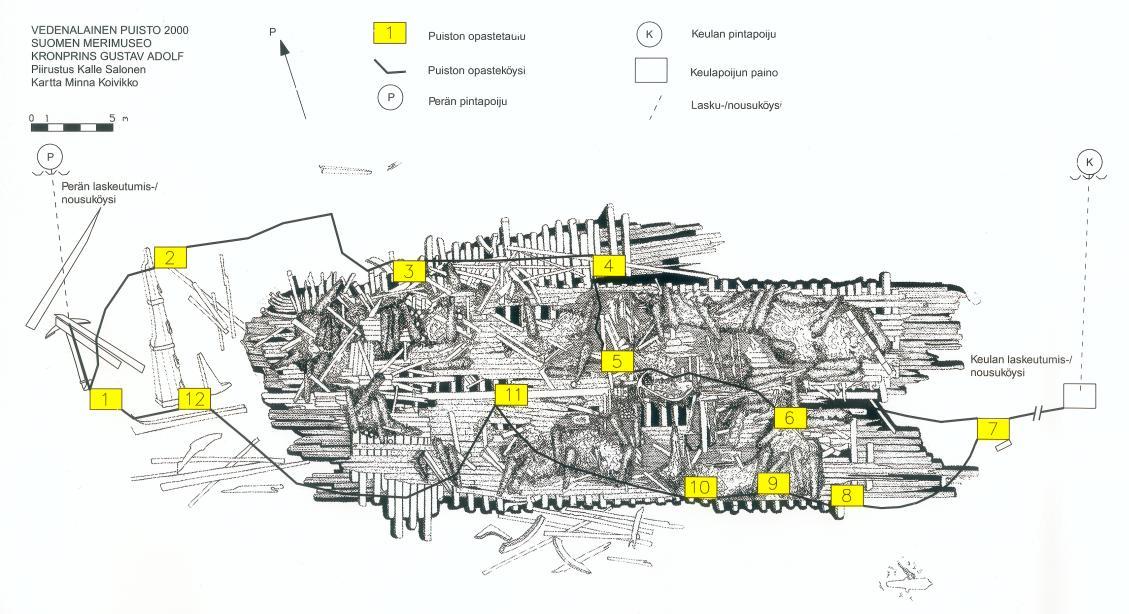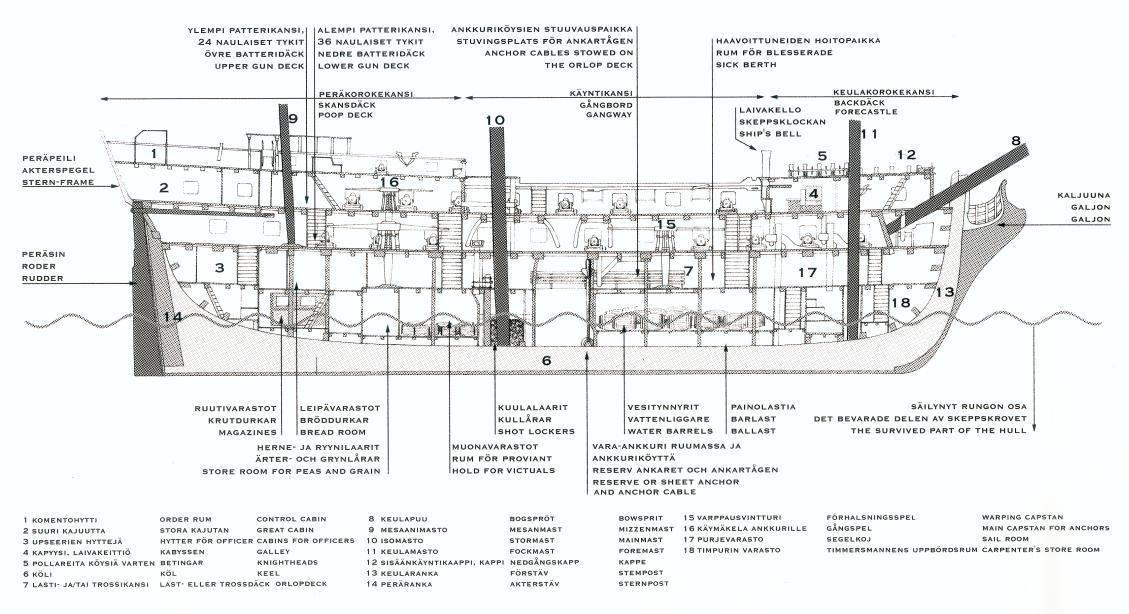
Helsinki underwater park Kronprins Gustav Adolf
Helsinki underwater park is now open for the summer season 2025. We wish you interesting and safe dives!
The first underwater park in the Baltic Sea was built in 2000 at the wreck of Kronprins Gustav Adolf, a ship of the Swedish line, off Helsinki. Finnish Heritage Agency is responsible for the park. The maintenance of the park is carried out in collaboration with Sea Safety Scandinavia Ltd. Entry to the wreck park is free. At the moment the park is open and will be closed before autumn storms.
The park is marked with a buoy, that can be used for mooring a boat. The wreck area is surrounded by an information path connected by a leading line, with information boards about the history of Kronprins Gustav Adolf and the ship’s structure. There are diving lines attached to the bow and aft of the wreck for the divers. The goal of underwater parks is to help visitors recognise and interpret what they see; a messy pile of planks can be interpreted as an old warship and a memory of passed event. The wreck park helps visitors to understand the enormous potential of the Baltic Sea as a unique ‘underwater outdoor museum’, where thousands of different wrecks have been preserved.
Before diving, divers must acquaint themselves with the regulations of the park and the diver’s map.
The wreck of Gustav Adolf is located in the water area of the City of Helsinki, approximately 3.5 nautical miles to south-southwest from the Harmaja lighthouse. The coordinates of the park are (WGS84) 60°03.010 N, 24°55.570 E. Depth: 19–21 metres, moraine/sand bottom, there are usually no strong currents, visibility is 1–10 metres, usually 4–6 metres.
Entry to the park is free. Divers move in the park by following the underwater rope path. Divers can study the wreck as closely as is possible without damaging it.
Large vessels passing the park may cause tall waves, always remember to leave someone in the boat during the diving. Finnish Heritage Agency wishes you happy and safe diving.
Inquiries about the park can be directed to the Finnish Heritage Agency researchers Päivi Pihlanjärvi, tel. +358 295 33 6209 and Minna Koivikko, tel. +358 295 33 6215.
Helsingin hylkypuistossa sukeltaminen ja covid-19
Sukella vain pienissä venekunnissa. Puiston järjestyssääntöjenkin mukaan veneen kiinnittymispoijussa saa olla kerrallaan vain yksi alus. Yritä pitää turvavälit myös pintatyöskentelyssä. Varmista sukellusvarusteidesi turvallisuus, äläkä desinfioimatta lainaa muille henkilökohtaisia varusteitasi, kuten annostimia tai maskeja. Älä osallistu sukellusmatkalle flunssaisena.
Tutustu myös Sukeltajaliiton koronavirusohjeistukseen sekä THL:n yleisohjeisiin viruksen leviämisen estämiseksi.
Jos olet jo sairastanut covid-19-taudin, tutustu ohjeistukseen ja sukelluskieltoihin taudin jälkeen. Myös oireettomana taudin sairastaneiden tulee noudattaa vähintään kuukauden mittaista sukelluskieltoa, oireisen covid-19-taudin jälkeen sukelluskielto on vähintään 2–3 kuukautta.
Helsingin hylkypuistossa vieraillaan itsenäisesti, joten kävijät ovat itse vastuussa omasta turvallisuudestaan ja hygieniastaan. Museovirasto toivottaa antoisia ja turvallisia sukelluksia hylkypuistossa.
Rules for the underwater park
Boats must be moored to the yellow mooring buoy for the duration of diving operations, but cannot be left unattended. The buoy’s mooring mechanism limits mooring to boats under 12 metres in length with a maximum weight of 15 tonnes.
The park is closed with winds exceeding 6 m/s in order to secure safe diving.
The wreck is situated at open sea where even light winds can cause rough seas. Also, there are busy shipping lanes causing waves close to the wreck site. There must be an adequate surface crew on the boat. The boat shall be moored on the buoy while somebody is diving at the wreck.
1. These rules must be followed
While diving at the underwater park, use the diver's map.
2. Aim of the rules
The aim of these rules is to guarantee pleasant and safe diving for everybody at the park. Caution must be exercised in all activities.
3. The antiquities act and protected area
Underwater remains of antiquity are protected by law. The protected area starts two metres from the visible outside borders of the target. In the underwater park, however, you can dive closer to the wreck. Remember though not to damage the wreck or to pick up any 'souvenirs'. Divers do not need a permission to dive at the underwater park, as is the case with all other wrecks over one hundred years old in Finland with the exception of four wrecks which have a protected area around them. Divers are allowed to take underwater photos at the wreck site. Any research work on the wreck has to be authorised.
4. Opening times and conditions
In order to dive in the park, we recommend that you will purchase a diver's map and a brochure in advance. Please familiarise yourself with the map before diving. Diving in the park is allowed during the summer months, and on the condition that these rules are followed. Diving is prohibited if wind speed exceeds 6 m/s.
5. Mooring
There is one specific buoy for mooring the boat by the wreck. The anchor of the buoy weighs about 6,000 kg. Only one boat at the time is allowed to moor at the buoy. The smaller round red buoys are for diving and surfacing lines; mooring a boat at them is prohibited. The distance from the mooring buoys to the diving lines is 50-70 m. When operating at the wreck site, pay attention to the traffic on the nearby shipping lanes and other sea traffic in the area.
6. Diving at the wreck site
There are two diving lines secured to two round red buoys near the wreck. One of the buoys has the text 'perä' (aft) and the other the text 'keula' (bow), leading to the aft and the bow of the wreck. There are corresponding texts at the lower ends of the diving lines. The diving route in the park is marked by a blue and white 14 mm rope, secured to small metal weighs and the information boards. The rope is equipped with yellow arrows indicating the diving direction. Please follow the diving direction. The information boards are yellow and A3 sized. There are 12 information boards and one 'Welcome' board.
- There must be adequate surface crew during the dive.
- Check your emergency communications equipment and make sure the emergency numbers are on hand.
- Diving happens at your own risk.
- Divers should be accompanied by a diving instructor. There should not be too many divers at the same time.
- Remember to fly the diving flag on your boat.
- Always dive in pairs.
- Remember to carry a torch.
- Dive and surface using the diving lines.
- Do not lose visual contact of the blue and white diving rope marking the diving route.
- Maximum depth at the wreck site is about 21 metres.
- Reserve about 25 min for diving the route.
- Remember to check your air.
- Follow standard diving safety precautions
7. At the end of the dive
Check that all divers are safely on board the boat. Remember to take down the diving flag.
8. Leaving the wreck site
Exercise caution when leaving the site. Pay attention to other boats and divers.
9. Other things to remember
When operating at the wreck site, underwater or on the surface, pay attention to other boats and divers. Leave the park in the same condition as you found it. If you notice any defects at the wreck site, please notify the Finnish Heritage Agency researcher Päivi Pihlanjärvi tel. +358 295 33 6209 and Minna Koivikko, tel. +358 295 33 6215.
Diver's maps


Kronprins Gustav Adolf
The Kronprins Gustav Adolf, the Swedish ship of the line, became destroyed and wrecked off Helsinki during the Russo-Swedish war in 1788. The wreck was discovered by the Finnish Navy in 1995. The wreck lies a few nautical miles southwest from the lighthouse island of Harmaja. The remains of the ship lie at 18-20 meters and are in part scattered on an area of approximately 100 x 100 meters. The wreck consists of the bottom of the hull, the sides, which have fallen down, different parts of the structure, cannons, cannon balls, and a variety of loose articles. All in all 71 cannons have been found at the site. Three of these were raised, conserved and examined. There are also two big iron anchors at the wreck.
In the 1780’s, the Swedish sea-going fleet was thoroughly reformed. It was decided that a number of ships of the line and smaller vessels were to be built, and indeed ten similar ships of the line were built at the shipyard of Karlskrona. The ships were designed by the naval architect Fredrik Henrik af Chapman, the best-known ship designer of the time and the head of Swedish shipbuilding from the year 1781. The building of the Kronprins Gustav Adolf lasted for several years; the ship was not completed until in 1784. Many other ships were built at the shipyard at the same time. The Kronprins Gustav Adolf was a big ship: its length was 49,6 meters and width 13,59 meters. Its weaponry consisted of 62 cannons. In the maritime archaeological research conducted between 1997-1999 it was found out, that there were actually more than 70 guns on board. According to a motion form 1788, there were 567 men in the crew, and 112 of these were naval seamen. The master of the ship was Colonel Christiernin.
At the beginning of August 1788, Swedish ships were on patrol in the Gulf of Finland. Some of the ships, including the Kronprins Gustav Adolf, were anchored for the night outside the fortress of Viapori (Sveaborg / Suomenlinna) off Helsinki. In the following morning, on the 6th of August, Russian vessels surprised the anchored Swedish ships. All of these except for the Gustav Adolf managed to escape. The Kronprins Gustav Adolf had difficulties when lifting one of its anchors, but in the end she managed to leave for the fortress. When fleeing, the ship struck a shoal that was previously unknown and lost the topmast of the mainmast. Also the bottom of the ship was damaged and water flew into the gunpowder store. After a few shots the ship had to surrender to the Russians. People later gave the shoal the name of “The Gustav Adolf ‘s Shoal”. The name can be found on naval charts of today.
The Swedish Second Lieutenant Gustav Klint described the events in his diary. He was commanded to sail and rescue the crew of the Kronprins Gustav Adolf but on his way to the ship there were two Russian frigates and the enemy was already by the Gustav Adolf too. The rescue operation failed. Russians took the crew of the Gustav Adolf as prisoners of war and set the ship of line on fire. In the end the ship exploded, floated and sank. Some of the prisoners of war spent years in Siberia and described that time as long and hard.